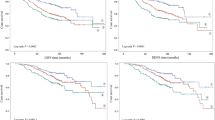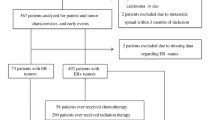Abstract
Obesity-related hormones and cytokines alter PI3 K-AKT-mTOR pathway activation in breast tumors contributing to poorer disease-free survival (DFS) and decreased responsiveness to tamoxifen and trastuzumab. We hypothesized that single nucleotide polymorphisms (SNPs) in candidate genes in the PI3 K-AKT-mTOR signaling pathway may act as genetic modifiers of breast cancer DFS. We analyzed the association of 106 tagging SNPs in 13 genes (ADIPOQ, IGF1, INS, IRS1, LEP, LEPR, LEPROT, PIK3CA, PIK3R5, PTEN, TSC1, TSC2, and AKT1) in the P13K-AKT-mTOR pathway with DFS in a sample of 1,019 women with stage I–II breast cancer. SNPs significantly associated with DFS in any genetic model (additive, dominant, or recessive) after correcting for false discovery rate (FDR = 0.10) were included in Cox proportional hazards multivariable analyses. After adjusting for race/ethnicity, age at diagnosis, tumor stage, and treatment, rs1063539 in ADIPOQ, rs11585329 in LEPR, and rs2519757 in TSC1 were associated with improved DFS, and rs1520220 in IGF1 and rs2677760 in PIK3CA were associated with worse DFS. The associations were not significantly modified by the type of systemic treatment received or body mass index. The SNPs were not associated with tumor characteristics such as tumor size, lymph node status, nuclear grade, or hormone receptor status. In this study, germline SNPs in the PI3 K-AKT-mTOR pathway were associated with breast cancer DFS and may be potential prognostic markers. Future studies are needed to replicate our results and to evaluate the relationship between these polymorphisms and activation of the PI3 K-AKT-mTOR pathway in breast tumors.

Similar content being viewed by others
Abbreviations
- PI3K:
-
Phosphatidylinositol-3 kinase
- mTOR:
-
Mammalian target of rapamycin
- ADIPOQ:
-
AdiponectinC1Q and collagen domain containing
- IGF1:
-
Insulin-like growth factor 1
- INS:
-
Insulin
- IRS1:
-
Insulin receptor substrate 1LEP: Leptin
- LEPR:
-
Leptin receptorLEPROT: Leptin receptor overlapping transcript
- mTOR:
-
Mammalian target of rapamycin
- mTORC1:
-
Mammalian target of rapamycin complex 1
- PIK3CA:
-
Phosphatidylinositol-45-bisphosphate 3-kinase, catalytic subunit alpha
- PIK3R5:
-
Phosphoinositide-3-kinaseregulatory subunit 5
- PTEN:
-
Phosphatase and tensin homolog
- TSC1:
-
Tuberous sclerosis 1
- TSC2:
-
Tuberous sclerosis 2
- AKT1:
-
V-Akt murine thymoma viral oncogene homolog 1
- SNP:
-
Single nucleotide polymorphism
- DFS:
-
Disease-free survival
- ESBCR:
-
Early stage breast cancer repository
- ER:
-
Estrogen receptor
- PR:
-
Progesterone receptor
- MAF:
-
Minor allele frequency
- LD:
-
Linkage disequilibrium
- HR:
-
Hazard ratio
- CI:
-
Confidence interval
References
Hennessy BT, Smith DL, Ram PT, Lu Y, Mills GB (2005) Exploiting the PI3K/AKT pathway for cancer drug discovery. Nat Rev Drug Discov 4(12):988–1004
Siegel R, Ma J, Zou Z, Jemal A (2014) Cancer statistics. CA Cancer J Clin 64(1):9–29
Hay N, Sonenberg N (2004) Upstream and downstream of mTOR. Genes Dev 18(16):1926–1945
Mamane Y, Petroulakis E, LeBacquer O, Sonenberg N (2006) mTOR, translation initiation and cancer. Oncogene 25(48):6416–6422
Bjornsti MA, Houghton PJ (2004) The TOR pathway: a target for cancer therapy. Nat Rev Cancer 4(5):335–348
Dutcher JP (2004) Mammalian target of rapamycin inhibition. Clin Cancer Res 10(18 Pt 2):6382S–6387S
Berns K, Horlings HM, Hennessy BT et al (2007) A functional genetic approach identifies the PI3K pathway as a major determinant of trastuzumab resistance in breast cancer. Cancer Cell 12(4):395–402
Chandarlapaty S, Sakr RA, Giri D et al (2012) Frequent mutational activation of the PI3K-AKT pathway in trastuzumab-resistant breast cancer. Clin Cancer Res 18(24):6784–6791
Karlsson E, Perez-Tenorio G, Amin R et al (2013) The mTOR effectors 4EBP1 and S6K2 are frequently coexpressed, and associated with a poor prognosis and endocrine resistance in breast cancer: a retrospective study including patients from the randomised Stockholm tamoxifen trials. Breast Cancer Res 15(5):R96
Kirkegaard T, Witton CJ, McGlynn LM et al (2005) AKT activation predicts outcome in breast cancer patients treated with tamoxifen. J Pathol 207(2):139–146
Lu CH, Wyszomierski SL, Tseng LM et al (2007) Preclinical testing of clinically applicable strategies for overcoming trastuzumab resistance caused by PTEN deficiency. Clin Cancer Res 13(19):5883–5888
Nagata Y, Lan KH, Zhou X et al (2004) PTEN activation contributes to tumor inhibition by trastuzumab, and loss of PTEN predicts trastuzumab resistance in patients. Cancer Cell 6(2):117–127
Razis E, Bobos M, Kotoula V et al (2011) Evaluation of the association of PIK3CA mutations and PTEN loss with efficacy of trastuzumab therapy in metastatic breast cancer. Breast Cancer Res Treat 128(2):447–456
Tevaarwerk AJ, Gray RJ, Schneider BP et al (2013) Survival in patients with metastatic recurrent breast cancer after adjuvant chemotherapy: little evidence of improvement over the past 30 years. Cancer 119(6):1140–1148
Chen M, Gu J, Delclos GL et al (2010) Genetic variations of the PI3K-AKT-mTOR pathway and clinical outcome in muscle invasive and metastatic bladder cancer patients. Carcinogenesis 31(8):1387–1391
Sun CH, Chang YH, Pan CC (2011) Activation of the PI3K/Akt/mTOR pathway correlates with tumour progression and reduced survival in patients with urothelial carcinoma of the urinary bladder. Histopathology 58(7):1054–1063
Yoshioka A, Miyata H, Doki Y et al (2008) The activation of Akt during preoperative chemotherapy for esophageal cancer correlates with poor prognosis. Oncol Rep 19(5):1099–1107
Brewster AM, Do KA, Thompson PA et al (2007) Relationship between epidemiologic risk factors and breast cancer recurrence. J Clin Oncol 25(28):4438–4444
Carlson CS, Eberle MA, Rieder MJ et al (2004) Selecting a maximally informative set of single-nucleotide polymorphisms for association analyses using linkage disequilibrium. Am J Hum Genet 74(1):106–120
Thorisson GA, Smith AV, Krishnan L, Stein LD (2005) The international hapmap project web site. Genome Res 15(11):1592–1593
QIAamp® DNA Mini and Blood Mini Handbook (2010) QIAGEN
Applied Biosystems® Arcturus® PicoPure® DNA Extraction Kit (2010)
Benjamini Y, Hochberg Y (1995) Controlling the false discovery rate: a practical and powerful approach to multiple testing. J Roy Stat Soc 57:289–300
Diorio C, Brisson J, Berube S, Pollak M (2008) Genetic polymorphisms involved in insulin-like growth factor (IGF) pathway in relation to mammographic breast density and IGF levels. Cancer Epidemiol Biomarkers Prev 17(4):880–888
Gu F, Schumacher FR, Canzian F et al (2010) Eighteen insulin-like growth factor pathway genes, circulating levels of IGF-I and its binding protein, and risk of prostate and breast cancer. Cancer Epidemiol Biomarkers Prev 19(11):2877–2887
Siddle K (2011) Signalling by insulin and IGF receptors: supporting acts and new players. J Mol Endocrinol 47(1):R1–R10
Davison Z, de Blacquiere GE, Westley BR, May FE (2011) Insulin-like growth factor-dependent proliferation and survival of triple-negative breast cancer cells: implications for therapy. Neoplasia 13(6):504–515
Zhang Y, Moerkens M, Ramaiahgari S et al (2011) Elevated insulin-like growth factor 1 receptor signaling induces antiestrogen resistance through the MAPK/ERK and PI3K/Akt signaling routes. Breast Cancer Res 13(3):R52
Key TJ, Appleby PN, Reeves GK, Roddam AW (2010) Insulin-like growth factor 1 (IGF1), IGF binding protein 3 (IGFBP3), and breast cancer risk: pooled individual data analysis of 17 prospective studies. Lancet Oncol 11(6):530–542
Hartog H, Boezen HM, de Jong MM et al (2013) Prognostic value of insulin-like growth factor 1 and insulin-like growth factor binding protein 3 blood levels in breast cancer. Breast 22(6):1155–1160
Pasanisi P, Venturelli E, Morelli D et al (2008) Serum insulin-like growth factor-I and platelet-derived growth factor as biomarkers of breast cancer prognosis. Cancer Epidemiol Biomarkers Prev 17(7):1719–1722
Mahadevan D, Sutton GR, Arteta-Bulos R et al (2014) Phase 1b study of safety, tolerability and efficacy of R1507, a monoclonal antibody to IGF-1R in combination with multiple standard oncology regimens in patients with advanced solid malignancies. Cancer Chemother Pharmacol 73(3):467–473
Khan S, Shukla S, Sinha S, Meeran SM (2013) Role of adipokines and cytokines in obesity-associated breast cancer: therapeutic targets. Cytokine Growth Factor Rev 24(6):503–513
Chen X, Xiang YB, Long JR et al (2012) Genetic polymorphisms in obesity-related genes and endometrial cancer risk. Cancer 118(13):3356–3364
Teras LR, Goodman M, Patel AV et al (2009) No association between polymorphisms in LEP, LEPR, ADIPOQ, ADIPOR1, or ADIPOR2 and postmenopausal breast cancer risk. Cancer Epidemiol Biomarkers Prev 18(9):2553–2557
Acknowledgments
This research was supported by the following grants–Susan Komen Career Catalyst Disparities Award (AMB), Komen Foundation Promise and SAC grant (GBM), Susan G. Komen for the Cure SAC110047 and SAB0800007 (MB), National Breast Cancer Foundation, and the National Cancer Institute at the NIH SPORE P50CA116199 (MB), National Institutes of Health R01 CA089608 (MB and PT), and National Institutes of Health K07 CA160753 (MP).
Author information
Authors and Affiliations
Corresponding author
Rights and permissions
About this article
Cite this article
Pande, M., Bondy, M.L., Do, KA. et al. Association between germline single nucleotide polymorphisms in the PI3K-AKT-mTOR pathway, obesity, and breast cancer disease-free survival. Breast Cancer Res Treat 147, 381–387 (2014). https://doi.org/10.1007/s10549-014-3081-9
Received:
Accepted:
Published:
Issue Date:
DOI: https://doi.org/10.1007/s10549-014-3081-9




